Click below to jump to an article of interest.
SwRI Wins 3 R&D 100 Awards
Three SwRI-developed technologies were selected as winners of prestigious R&D 100 Awards. R&D Magazine recognized SwRI's Catalyzed Diesel Exhaust Fluid (Cat-DEF™), Eco-Mobility with Connected Powertrains and Floodlight™ Non-Targeted Analysis System as being among the 100 most significant innovations for 2021.
"We are committed to solving difficult technology challenges with innovative approaches," said SwRI President and CEO Adam L. Hamilton, P.E. "I am honored that SwRI remains on the forefront of technological advancement. It is an incredible honor to be recognized for having three of the top 100 most significant innovations of the year."
The R&D 100 Awards are among the most prestigious innovation awards programs, honoring the top 100 revolutionary technologies each year since 1963. Recipients hail from research institutions, academic and government laboratories, Fortune 500 companies and smaller organizations. Since 1971, SwRI has won 50 R&D 100 Awards. This year's winners were announced October 19–21 by virtual broadcast from Cleveland.
Cat-DEF
Catalyzed Diesel Exhaust Fluid, or Cat-DEF, is a catalyst- and surfactant-modified diesel exhaust fluid (DEF) solution designed to reduce oxides of nitrogen (NOx) and carbon dioxide emissions from diesel engines by minimizing deposit formation in exhaust systems. The SwRI-developed Cat-DEF technology has been shown to help automotive manufacturers meet new California Air Resources Board NOx regulations without negative implications.
"This is truly a revolutionary technology," said Dr. Cary Henry, Cat-DEF principal investigator and a staff engineer in SwRI's Powertrain Engineering Division. "We are addressing future environmental regulatory challenges while minimizing cost to the market. Our novel technology is also backward compatible, which allows it to be used on older as well as current applications. This technology offers a new way to improve existing fluids onboard diesel vehicles while reducing NOx emissions and fuel consumption without negatively impacting hardware costs or durability."
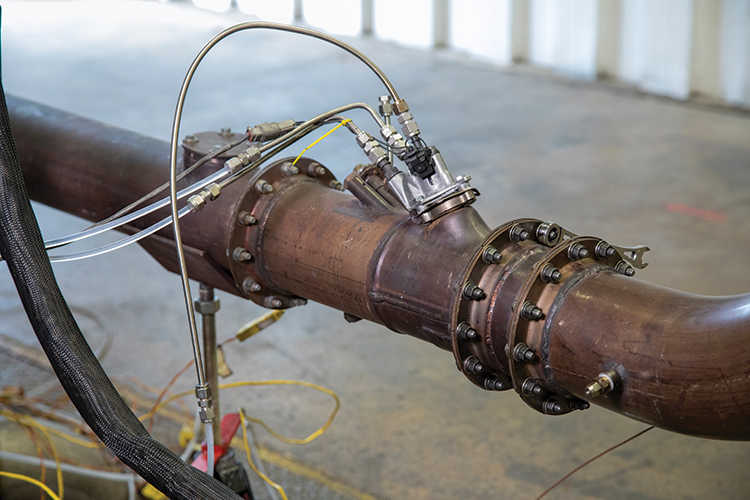
SwRI’s Cat-DEF™ technology was recognized for reducing nitrous oxide (NOx) and carbon dioxide emissions by minimizing deposit formation in diesel engine exhaust systems.
Currently, selective catalytic reduction (SCR), an advanced emissions control system, is used to abate NOx emissions. DEF is injected into the exhaust stream and ideally decomposes to form ammonia, which reacts with NOx on the SCR catalyst to form N2 and H2O. Although this process is relatively efficient at temperatures greater than 250°C, at temperatures below 250°C, urea-derived deposits form within the aftertreatment system. These deposits severely limit low-temperature NOx conversion and increase fuel consumption as high-temperature engine operations are required to remove the deposits.
Cat-DEF laboratory results have confirmed a deposit reduction potential of up to 98% during low-load operations. With the reduction in deposit formation, the Cat-DEF system can support a 90% reduction in harmful NOx emissions and a 2% reduction in fuel consumption for heavy-duty diesel trucks. Rigorous engine testing shows that the solutions can help automotive manufacturers cost-effectively meet future emission regulations for heavy-duty and off-highway mobile machinery, while improving performance in existing vehicles.
Eco-Mobility with Connected Powertrains
SwRI's connected and automated vehicle (CAV) technology will help passenger and fleet vehicles reduce energy consumption. Developed in cooperation with the Advanced Research Projects Agency-Energy, Toyota and the University of Michigan, SwRI's Eco-Mobility with Connected Powertrains project delivered over 20% energy savings on a plug-in hybrid vehicle in real-world driving conditions by optimizing power management, routing and speed.
"Eco-Mobility with Connected Powertrains provides a breakthrough toward dramatically lowering automotive fuel consumption as government and industry seek scalable solutions to lower automotive carbon dioxide (CO2) emissions," said Terry Alger, director of SwRI's Automotive Propulsion Systems Department.
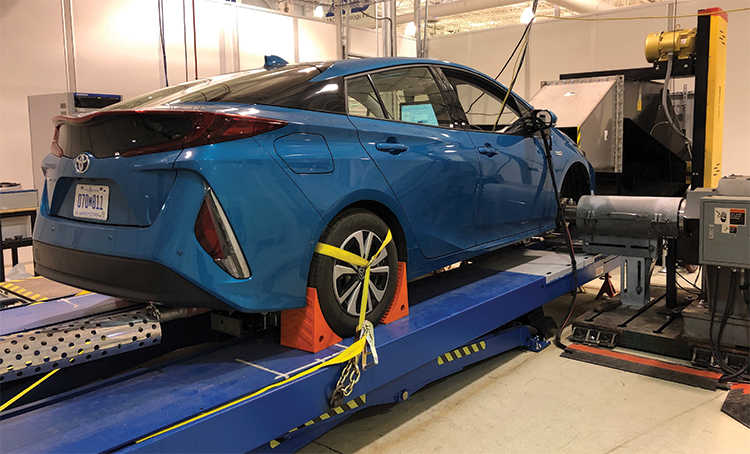
SwRI developed a connected and automated vehicle (CAV) chassis dynamometer that interfaces with traffic simulation software to provide a controllable, repeatable environment for testing tools.
The research vehicle features an 8.8 kW-hr battery pack and onboard dedicated short-range communication (DSRC) radio for vehicle-to-vehicle (V2V) and vehicle-to-infrastructure (V2I) communications. Algorithms optimize hybrid-electric performance through a novel strategy that improves management of power as it moves through the battery, electric motor, gasoline engine and other powertrain components. The "connected powertrain" further improves efficiency via V2V and V2I networks that communicate optimal routes and speed.
"Most production hybrid vehicles use a charge-deplete then charge-sustain strategy for battery pack power management, which results in suboptimal efficiency depending on route," said Sankar Rengarajan, manager of SwRI's Powertrain Controls Section. "SwRI's algorithms leverage route information to optimize power usage and fuel efficiency by adjusting the power split between the battery/electric motor and the gasoline engine."
SwRI developed the technology through initial funding from the U.S. Department of Energy Advanced Research Projects Agency-Energy (ARPA-E) NEXTCAR program, which uses connectivity and automation to improve vehicle energy efficiency. SwRI's internal research and external client funding further developed capabilities.
"This connected powertrain technology does not require high levels of automation or redesign of powertrain systems," said Scott Hotz, assistant director of SwRI's Automotive Propulsion Systems Department. "The required connectivity already exists on some current production vehicles, and CAV networks will be ubiquitous in 5–10 years."
Floodlight
SwRI's Floodlight software aids in the efficient discovery of vast numbers of chemicals present in a wide variety of substances including food, air and consumer products. This cheminformatics machine learning tool, developed with internal funding, integrates with analytical chemistry software to provide deep analysis of two-dimensional gas chromatography mass spectrometry (GCxGC-MS) and metadata.
Floodlight is a game changer for processing non-targeted analysis (NTA) data. In NTA, all substances detected by GCxGC-MS instruments are evaluated, producing vast amounts of data. Targeted analyses screen for specified chemicals, producing more limited results.
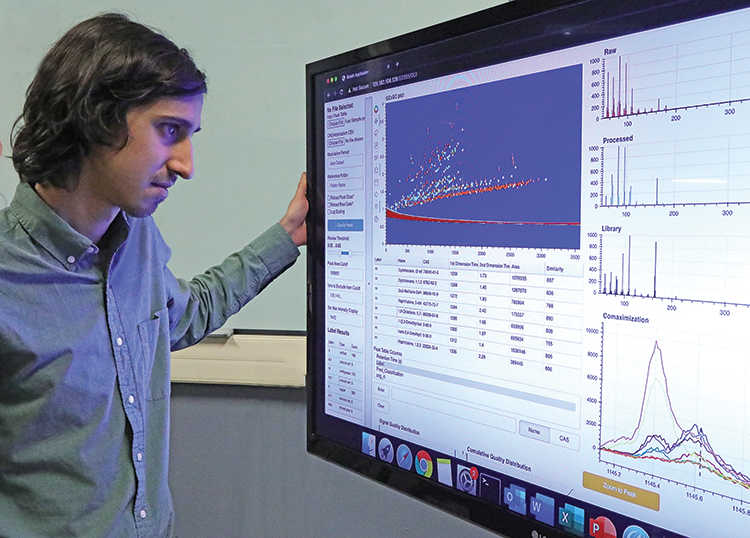
SwRI's award-winning Floodlight software displays the results of processed non-targeted chemical analyses using an intuitive web interface that can be accessed using most modern web browsers.
"Known chemicals in a particular sample are relatively easy to find and quantify," said Dr. Kristin Favela, an analytical chemist specializing in chemical forensics and one of the leaders of the development team. "NTA is a different story. Through an extensive, multiyear NTA program of consumer products, we discovered that only about 20% of identified chemicals were listed on product labels or datasheets. The remaining 80% were previously unidentified in these products. We don't know the possible health effects of exposure to chemicals if we don't know they are in products."
SwRI was well positioned to attack this issue, with wide-ranging expertise in analytical chemistry, machine learning, data science and engineering. Key to the Floodlight technology is SwRI's experience in labeling ground-truth data for chemicals in a wide array of consumer products, ranging from food and medicine to packaging and toys. SwRI's machine learning team, led by Michael Hartnett and David Vickers, leveraged this data to train and develop new algorithms.
"The key to the Floodlight software is artificial intelligence and machine learning algorithms that enable advanced analysis of chemistry big data," said Dr. Keith Pickens, one of the leaders of the Artificial Intelligence for Mass Spectrometry (AIMS) group at SwRI. "The Floodlight software is a sophisticated software tool that can make sense of the vast amounts of data NTA generates."
Earth Bombardment History: Zeroing in on Source of Dinosaur-Killing Impactor
The impactor believed to have wiped out the dinosaurs and many other life forms on Earth some 66 million years ago likely came from the outer half of the main asteroid belt, a region previously thought to produce few impactors. SwRI researchers have shown that the processes that deliver large asteroids to Earth from that region occur at least 10 times more frequently than previously thought and that the composition of these bodies matches what we know of the dinosaur-killing impactor.
The SwRI team — including Dr. David Nesvorný, Dr. William Bottke and Dr. Simone Marchi — combined computer models of asteroid evolution with observations of known asteroids to investigate the frequency of so-called Chicxulub events. Over 66 million years ago, a body estimated to be 6 miles across hit near what is now Mexico's Yucatan peninsula and formed the Chicxulub crater, which is over 90 miles across. This massive blast triggered a mass extinction event that ended the reign of the dinosaurs.

Courtesy of SwRI/Don Davis
An SwRI team modeled evolutionary processes in the main asteroid belt and discovered that impactors such as the one that ended the reign of the dinosaurs are most likely from the outer half of the main asteroid belt. The team also discovered that delivery processes from that region occur 10 times more often than previously thought.
To probe the Chicxulub impact, geologists have previously examined 66-million-year-old rock samples found on land and within drill cores. The results indicate the impactor was similar to the carbonaceous chondrite class of meteorites, which contain some of the most pristine materials in the solar system. Curiously, while carbonaceous chondrites are common among the many mile-wide bodies that approach the Earth, none of those found to date is close to the size needed to produce a Chicxulub-scale impact with any kind of reasonable probability.
"We decided to look for where the siblings of the Chicxulub impactor might be hiding," said Nesvorný, lead author of a paper in the journal Icarus describing the research.
"To explain their absence, several past groups have simulated large asteroid and comet breakups in the inner solar system, looking at surges of impacts on Earth with the largest one producing the Chicxulub crater," said Bottke, one of the paper's co-authors. "While many of these models had interesting properties, none provided a satisfying match to what we know about asteroids and comets. It seemed like we were still missing something important."
To solve this problem, the team used computer models that track how objects escape the main asteroid belt, a zone of small bodies located between the orbits of Mars and Jupiter. Over eons, thermal forces allow these objects to drift into dynamical "escape hatches" where the gravitational kicks of the planets can push them into orbits nearing Earth. Using NASA's Pleaides supercomputer, the team followed 130,000 model asteroids evolving in this slow, steady manner for hundreds of millions of years. Particular attention was given to asteroids located in the outer half of the asteroid belt, the part that is farthest from the Sun. To their surprise, they found that 6-mile-wide asteroids from this region would strike the Earth at least 10 times more often than previously calculated.
"This result is intriguing not only because the outer half of the asteroid belt is home to large numbers of carbonaceous chondrite impactors, but also because the team's simulations can, for the first time, reproduce the orbits of large asteroids on the verge of approaching Earth," said co-author Marchi. "Our explanation for the source of the Chicxulub impactor fits in beautifully with what we already know about how asteroids evolve."
Earth Bombardment History: New Impact Model Supports Atmospheric Oxygen History
An SwRI-led team has updated its asteroid bombardment model of the Earth with the latest geologic evidence of ancient, large collisions. These models have been used to understand how impacts may have affected oxygen levels in the Earth's atmosphere in the Archean eon, 2.5 to 4 billion years ago.
When large asteroids or comets struck early Earth, the energy released melted and vaporized rocky materials in the Earth's crust. The small droplets of molten rock in the impact plume would condense, solidify and fall back to Earth, creating round, globally distributed sand-size particles. Known as impact spherules, these glassy particles populated multiple thin, discrete layers in the Earth's crust, ranging in age from about 2.4 to 3.5 billion years old. These Archean spherule layers are markers of ancient collisions. New spherule layers recently identified in drill cores and outcrops have increased the total number of known impact events upon early Earth.
"Current bombardment models underestimate the number of late Archean spherule layers, suggesting that the impactor flux at that time was up to 10 times higher than previously thought," said SwRI's Dr. Simone Marchi, lead author of a paper about this research in Nature Geoscience. "What's more, we find that the cumulative impactor mass delivered to the early Earth was an important 'sink' of oxygen, suggesting that early bombardment could have delayed oxidation of Earth's atmosphere."

Courtesy of SwRI/Dan Durda, Simone Marchi
A Southwest Research Institute-led team updated planetary bombardment models with the latest geologic information and then applied those models to understand how impacts may have affected oxygen levels in the Earth's atmosphere in the Archean eon, 2.5 to 4 billion years ago. This artistic conception illustrates large asteroids penetrating Earth's oxygen-poor atmosphere.
The abundance of oxygen in Earth's atmosphere is due to a balance of production and removal processes. These new findings correspond to the geological record, which shows that oxygen levels in the atmosphere varied but stayed relatively low in the early Archean eon. Impacts by bodies larger than 6 miles (10 km) in diameter may have contributed to its scarcity, as limited oxygen present in the atmosphere of early Earth would have been chemically consumed by impact vapors, further reducing its abundance in the atmosphere. Scientists have found evidence for 'whiffs' of oxygen, relatively steep but transient increases in atmospheric oxygen, around 2.5 billion years ago. Large impacts, consistent with those recorded by spherule layers in Australia's Bee Gorge and Dales Gorge, could have removed the whiffs from the atmosphere.
SwRI's results indicate that the Earth was subject to substantial numbers of large impacts throughout the late Archean era. Around 2.4 billion years ago, during the tail end of this bombardment, the Earth went through a major shift in surface chemistry triggered by the rise of atmospheric oxygen, dubbed the Great Oxidation Event (GOE), which is attributed to changes in the oxygen production-sink balance. Among the proposed scenarios are a presumed increase in oxygen production and decrease in gases capable of removing oxygen, either from volcanic sources or through their gradual loss to space.
"Impact vapors caused episodic low oxygen levels for large spans of time preceding GOE," Marchi said. "As time went on, collisions became progressively less frequent and too small to be able to significantly alter post-GOE oxygen levels. The Earth was on its course to become the current planet."
SwRI, UTSA Connect Through Collaborative Research
Southwest Research Institute and The University of Texas at San Antonio (UTSA) funded two projects through the Connecting Through Research Partnerships (Connect) program: one to produce cleaner renewable liquid hydrocarbon fuels for transportation, and another to create a computer model of the human heart. SwRI's Executive Office and UTSA's Office of the Vice President for Research, Economic Development, and Knowledge Enterprise sponsor the Connect program, which offers grant opportunities to enhance scientific collaboration between the two institutions.
Heart Models to Support New Treatments
SwRI and UTSA are collaborating to develop a computer model of the intricate structures of the human heart as part of a larger effort to develop a new, potentially life-saving heart surgery. The work, led by Dr. Keith Bartels of SwRI's Mechanical Engineering Division and Dr. Hai-Chao Han of UTSA's College of Engineering, is supported by a $125,000 Connect grant.
Within the human heart are numerous small muscle bundles called the trabeculae carneae. Despite their significance in the heart's anatomy, their function is not well understood and most models of the heart ignore them.
As people grow older, heart muscles can grow stiff, reducing efficiency and sometimes resulting in untreatable diastolic heart failure. SwRI and UTSA are scanning cadaver hearts using SwRI's powerful computer tomography (CT) scanner to inform a potential new surgical intervention.
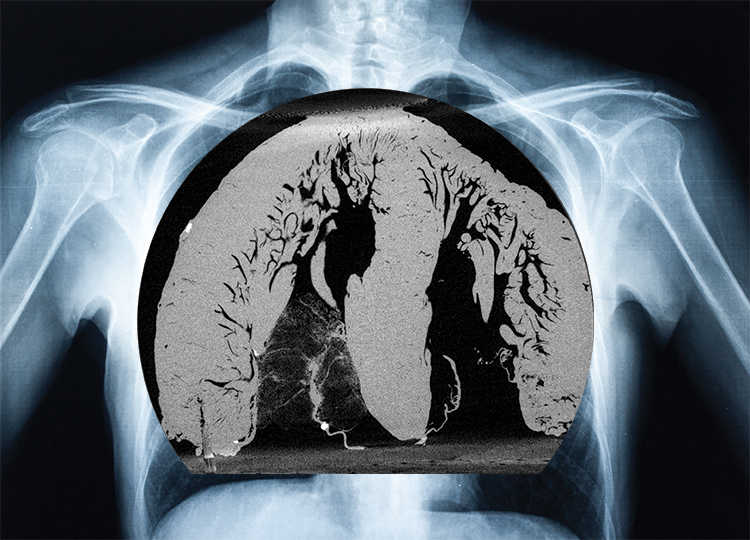
SwRI is using its micro-focus x-ray CT scanner to image the intricate inner structures of the heart. Using these images, an SwRI-UTSA team will develop a computer model of the human heart as part of a larger effort to develop a new, potentially life-saving heart surgery.
"Capturing the intricate structures of the trabeculae carneae requires something more powerful than an MRI or standard CT scanner," Bartels said. "We'll utilize a micro-focus X-ray CT scanner here at SwRI to create images of explanted human hearts."
The images of the heart's intricate inner structures will help Han create a realistic anatomical model of the trabeculae carneae, building on a previous model he developed for the left ventricle.
"This collaboration with SwRI is a first step toward creating a new surgical method," Han explained. "The computer model will help provide a much deeper understanding of the trabeculae carneae."
Han has also been working with cardiologist Dr. Marc Feldman at UT Health San Antonio to develop a surgical treatment for subgroups of heart failure patients. This project is a critical step for those efforts.
"I hope this work can ultimately improve the quality of people's lives and even save lives in the long run," Bartels said. "Heart failure is a major problem that affects millions of people."
Cleaner Renewable CO2-Based Hydrocarbons
SwRI and UTSA also are collaborating to combine two catalytic processes into a single reactor, with the overall goal of recycling carbon from carbon dioxide (CO2) to produce low-cost hydrocarbon fuels. The work, led by Dr. Grant Seuser of SwRI's Powertrain Engineering Division and Dr. Gary Jacobs of UTSA's College of Engineering, is supported by a $125,000 Connect grant.
Greenhouse gas emissions are expected to increase by about 17% by 2040 as a result of increasing energy and transportation needs in the developing world.
"We're facing a lack of renewable fuels and the technology to deliver cleaner power generation," Seuser said. "We're seeing a rise in battery-powered passenger vehicles, but the high power demands of the aviation, locomotive, shipping and long-haul trucking industries will continue to require energy-dense hydrocarbons for the foreseeable future."
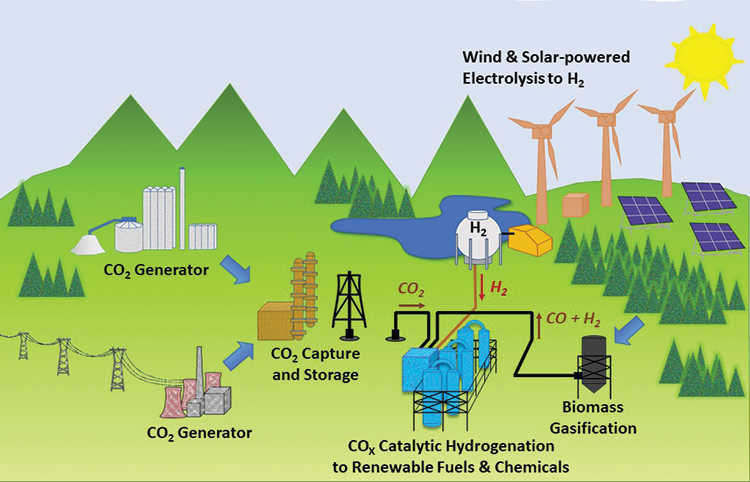
Courtesy of UTSA
The graphic illustrates sustainable hydrocarbon production through recycling carbon — CO and/or CO2, referred to as COX — hydrogenating CO2 and/or biomass gasification to create renewable liquid fuels.
Seuser and Jacobs propose using a process called CO2 hydrogenation to produce cleaner renewable liquid hydrocarbon fuels for transportation. To accomplish this, they plan to build a single reactor capable of performing two chemical processes in one step. The first will react hydrogen with CO2 to make synthesis gas (syngas), a combination of hydrogen and carbon monoxide; the second will convert the syngas into a liquid hydrocarbon fuel using the Fischer-Tropsch synthesis process.
"Fischer-Tropsch synthesis was discovered in Germany about a century ago and is still used in places like South Africa and Qatar to convert coal and natural gas into liquid hydrocarbon fuels. Plant capacities range from tens of thousands to hundreds of thousands of barrels of fuel per day. It will be an interesting challenge to integrate this catalytic technology into a process that uses CO2 in the feed," Jacobs said.
Additionally, the process the SwRI-UTSA team is developing will be able to use CO2 captured at fossil fuel-fired power plants that would otherwise be sequestered underground or emitted into the atmosphere.
"Combining the functionality of these two catalytic processes — reverse water-gas shift and Fischer-Tropsch synthesis — into a single reactor would simplify the process and increase its economic viability," Jacobs said.
The effort will also explore novel catalyst formations aimed at combining the two processes, which Jacobs will create and characterize at UTSA. Seuser will use the catalysts in an SwRI reactor to assess their industrial viability.
"Reducing the complexity of converting CO2 into hydrocarbon fuels would have a big impact," Seuser said. "Finding a way to produce low-carbon fuels and maintain our current energy infrastructure is critical to avoid further increases in Earth's temperature."

Grid-Scale Battery JIP Launched
SwRI has launched a new Joint Industry Program (JIP) to investigate energy storage systems for the electric grid. JIP efforts will include developing new test cycles for batteries used in grid applications and estimating the life span of batteries and their potential for failure while reducing the likelihood of battery fires.
"The energy industry has seen a tremendous increase in renewable resources, such as power generated by wind turbines and solar panels," said Dr. Jayant Sarlashkar, an Institute engineer in SwRI's Powertrain Engineering Division. "These renewable sources tend to be highly variable, so it becomes necessary to store excess energy in a battery for use during periods of high demand. The increased role of renewable resources in the energy mix has led to a greater demand for batteries to store energy to balance supply and demand."
Tokyo Electric Power Company (TEPCO), ENGIE, EnBW, the Central Research Institute of Electric Power Industry (CRIEPI) and CEZ have joined SwRI's Energy Storage for Electric Grid JIP, which will address questions about the risks and reliability of energy storage systems, including battery degradation.
"Once we deploy a battery for grid applications, we need to know how long we can rely upon it," Sarlashkar said.
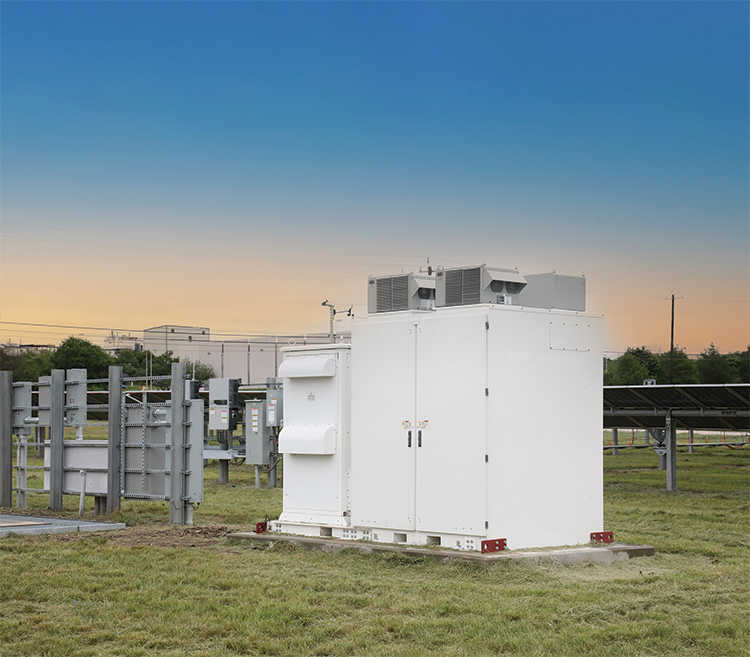
Over the course of its life, a grid-connected battery must be able to respond slowly or suddenly, depending on grid demands. On a normal evening, a battery might supply 1,000 houses with continuous power, which is a slow and sustained behavior. But in an emergency, that same battery could be called upon to supply an immediate surge of electricity to prevent a blackout. The program will investigate how these two very different demand scenarios affect the life of a battery.
The Energy Storage for Electric Grid JIP will also investigate battery flammability, particularly the explosion and fire risks associated with large, grid-scale batteries.
"Actions such as aggressive load-shifting and deploying a battery to prevent a blackout could increase fire risks," Sarlashkar said. "The current monitoring standards are insufficient."
Understanding how a battery degrades and the likelihood of its failure could shed light on what causes battery fires. SwRI is working on methods to estimate performance degradation in grid-connected batteries and establish a correlation with battery fires. One known risk for a lithium-ion battery fire is the presence of dendrites, spiky structures deposited during the charging process, which can cause short-circuits and fires.
"We want to know how fast these dendrites grow, because that will tell us when it's time to replace a battery," Sarlashkar said. "The more we know about what causes these fires, the better we can develop maintenance protocols to prevent them by replacing batteries before they cause damage and injury."
Joining the JIP requires signing a cooperative research agreement and providing operational field data from a grid battery the JIP participant has deployed. SwRI is funding this JIP through internal research, with the other JIP members providing in-kind support, so there is no fee to join.
Participants can guide JIP research to keep it true to the needs of the industry. They also have the opportunity to license any intellectual property developed before SwRI offers it to JIP non-participants, which may provide a competitive advantage by reducing life-cycle costs.
This new JIP will utilize SwRI's grid-connected energy storage facilities at its San Antonio headquarters.
SwRI Collaborates with Virgin Orbit
Virgin Orbit, a California-based small satellite launch company, and SwRI have signed a memorandum of understanding (MOU) establishing a new collaboration. Under the terms of the agreement, Virgin Orbit and SwRI will explore specialized mission opportunities using the LauncherOne rocket coupled with SwRI's deep expertise in space mission development. Additionally, the two organizations will explore potential opportunities for joint manufacturing of SwRI's space platforms and delivery of space services to Virgin Orbit's customers.
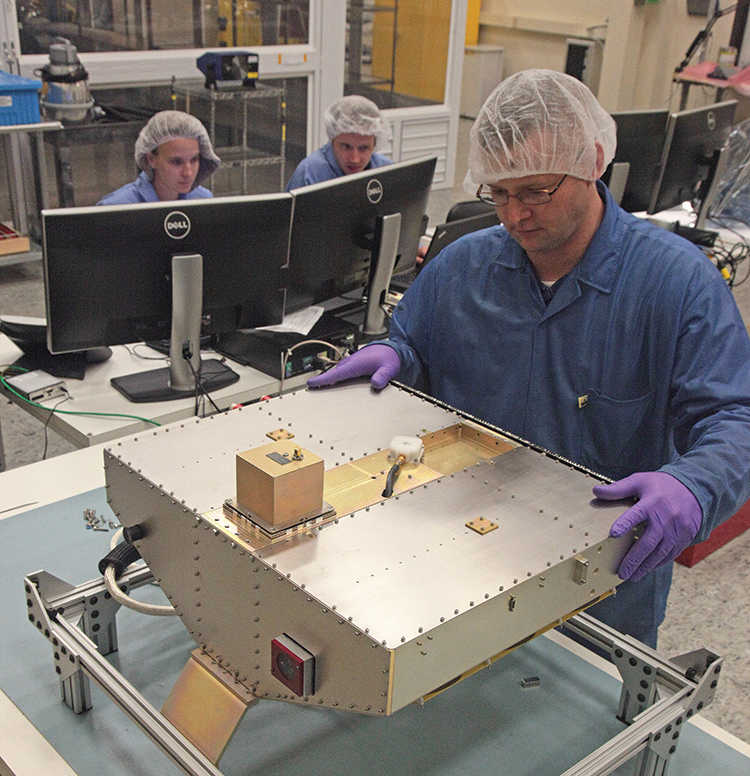
As part of a new collaboration, Virgin Orbit and SwRI will evaluate opportunities to jointly develop and launch missions to space, including the deployment of satellite constellations similar to NASA's Cyclone Global Navigation Satellite System. SwRI designed, built and operates the eight CYGNSS microsatellites for a NASA weather monitoring mission.
Virgin Orbit is interested in developing collaborations to offer its government, civil and commercial customers turnkey bundled services, such as satellite platforms, mission management and downstream value-added services and applications. Virgin Orbit and SwRI are particularly interested in collaborating on stewardship programs that would leverage space data to inform critical decisions around weather and for environmental monitoring purposes.
As part of the agreement, Virgin Orbit will assess the possibility of manufacturing SwRI space vehicle platforms at the company's manufacturing hub in Long Beach, California. SwRI has two small satellite platforms available through NASA's Rapid Spacecraft Development Office IV catalog, which is used by the U.S. government to rapidly contract for flight-proven spacecraft. Virgin Orbit and SwRI will also evaluate opportunities to jointly develop and launch missions to space, including the deployment of satellite constellations, to provide comprehensive space service offerings to customers.
Heavy Ion Acceleration in Cosmic Rays
Using data from the SwRI-led Magnetospheric Multiscale (MMS) mission, scientists can explain the presence of energetic heavy elements in galactic cosmic rays (GCRs). GCRs are composed of fast-moving energetic particles, mostly hydrogen ions called protons, the lightest and most abundant elements in the universe. Scientists have long debated how trace amounts of heavy ions in GCRs are accelerated.
The supernova explosion of a dying star creates massive shockwaves that propagate through the surrounding space, accelerating ions in their path to very high energies, creating GCRs. How heavy ions are energized and accelerated is important because they affect the redistribution of mass throughout the universe and are essential for the formation of even heavier and more chemically complex elements. They also influence how we perceive astrophysical structures.
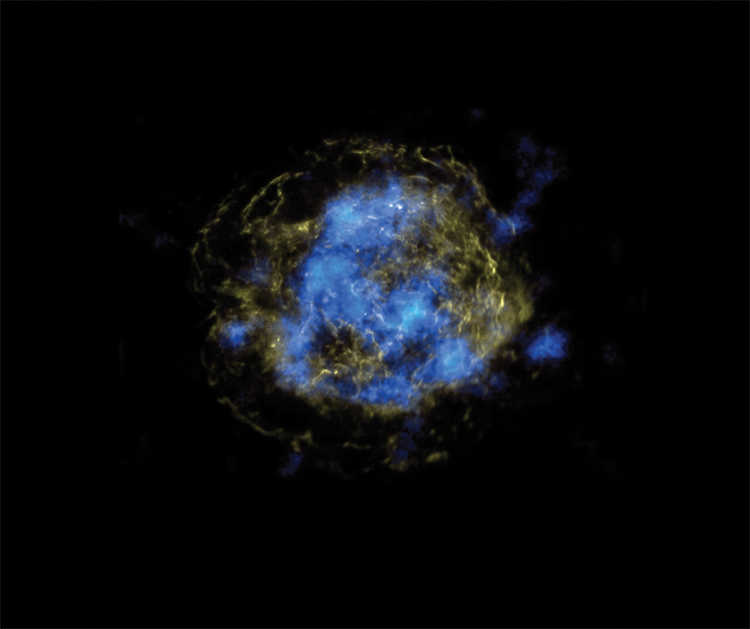
Courtesy of NASA/GSFC/JPL
Supernovas, such as this Cassiopeia A supernova remnant, are a source of galactic cosmic rays.
"Heavy ions are thought to be insensitive to an incoming shockwave because they are less abundant, and the shock energy is overwhelmingly consumed by the preponderance of protons. Visualize standing on a beach as waves move the sand under your feet, while you remain in place," said SwRI's Dr. Hadi Madanian, the lead author of the paper about this research published in Astrophysical Journal Letters. "However, that classical view of how heavy ions behave under shock conditions is not always what we have seen in high-resolution MMS observations of the near-Earth space environment."
The Sun's magnetic field is carried through interplanetary space by the flow of the supersonic solar wind, which is obstructed and diverted by the Earth's magnetosphere, a bubble of protection around our home planet. This interaction region is called the "bow shock" due to its curved shape, comparable to the bow waves that occur as a boat travels through water. The Earth's bow shock forms at a much smaller scale than supernova shocks. However, at times conditions of this small shock resemble those of supernova remnants. The team used high-resolution in-situ measurements from the MMS spacecraft at the bow shock to identify evidence for an acceleration process that drives heavy ions.
EZ Flow for Heavy Crudes
SwRI scientists and engineers used internal research funding to develop "EZ Flow," an innovative process that makes pipeline transportation of heavy crude oil more cost-effective and less energy-intensive than current techniques.
"Our team developed the new method for processing heavy crude oil using a proprietary chemical treatment and mechanical technique," said James Wood, a principal scientist in SwRI's Chemistry and Chemical Engineering Division. "The new process reduces the viscosity of heavy crude oil by more than 60%, allowing it to flow more easily through existing pipeline networks."

The U.S. has more than 190,000 miles of liquid petroleum pipeline networks, providing an environmentally friendly, economic way to move oils over long distances. However, transporting heavy crude oil and bitumen via pipeline is challenging at best and impossible at worst due to its high density and viscosity and very low mobility at reservoir temperatures. SwRI's proof-of-concept EZ Flow technology offers a cost-effective means for conveying heavy and extra-heavy crude oils over long distances without heating the pipeline and/or adding large amounts of chemical or diluent. Conventional techniques are costly because they often use large volumes of chemicals or diluents and frequently require multiple treatment techniques to be applied simultaneously.
"According to industry experts, over the next 80 years, heavy crude oil production will increase exponentially as lighter crude oil reserves dwindle and those that are available become more expensive and difficult to recover," Wood said.
The low concentrations of proprietary additives needed for EZ Flow make it environmentally friendlier and less expensive than other currently available commercial technologies. SwRI is also investigating whether EZ Flow could be adapted to upgrade, or chemically treat, heavy crude oil. SwRI's patent-pending EZ Flow proof-of-concept technology is available for commercial development.
Enabling Instrument for Lunar Surveys
NASA has funded SwRI's Environmental Analysis of the Bounded Lunar Exosphere (ENABLE) project, which aims to return mass spectrometry to the lunar surface. The three-year, $2.18 million program seeks to adapt a commercial off-the-shelf mass spectrometer into a design to identify materials present on the Moon.
Mass spectrometry instruments can identify unknown compounds, quantify known compounds and determine the structure and chemical properties of molecules. The proposed lunar design could be deployed on multiple spaceflight platforms, including lunar surface landers and robotic rovers, as well as a handheld tool suitable for operation by future astronauts.
"Whether it's prospecting for lunar volatiles, monitoring spacecraft exhaust byproducts, probing the eons-old history of the lunar subsurface or hunting for leaks from micrometeoroid impacts, we believe mass spectrometry is going to lead the way in surveying the Moon's harsh environment," said SwRI's Edward Patrick, ENABLE principal investigator.

Nearly half a century after Apollo, NASA lunar missions such as the Lunar Crater Observation and Sensing Satellite, the Lunar Reconnaissance Orbiter and the Lunar Atmosphere and Dust Environment Explorer have conducted remote sensing to search for trapped volatiles, chemical substances that can be readily vaporized. These discoveries have jump-started the field of "in situ resource utilization" or ISRU, which would allow explorers to "live off the land" at target worlds such as the Moon and Mars.
ISRU holds the promise of reducing the size of payloads necessary for future missions by excavating reservoirs of natural resources for breathable air and rocket fuel or producing engineered materials for space architecture and construction. It could also increase science payload capacity, reduce mission risks, support extended human-crewed missions, and, ultimately, allow a permanent human presence on the Moon and beyond.
"It's past time for mass spectrometry to return to the Moon," Patrick said. "With the armada of multinational space missions currently under development and on the drawing board, mass spectrometry is a priority diagnostic tool necessary for ISRU success."
Creating Water Out of Thin Air
SwRI engineers and chemists teamed up to create a low-cost method of harvesting water from atmospheric air on a much larger scale than previously attempted. Supported by internal research funding, the group is using silica gel beads, commonly used to keep items from gathering moisture during shipment, to capture water molecules from the air.
"The air around us always contains some water vapor," said Program Manager Kevin Supak. "For instance, a cold beverage on a humid day will form liquid water on the glass, condensed from the air. We can capture that moisture and turn it into a resource."
Communities around the world are facing water shortages. The SwRI solution uses adsorption to harvest atmospheric water. Even at low humidity, water vapor molecules in the air attach to the surface of materials called desiccants, such as the low-cost silica gel beads used in the SwRI process. Atmospheric air is blown through a bed of silica gel beads to adsorb the water vapor molecules.
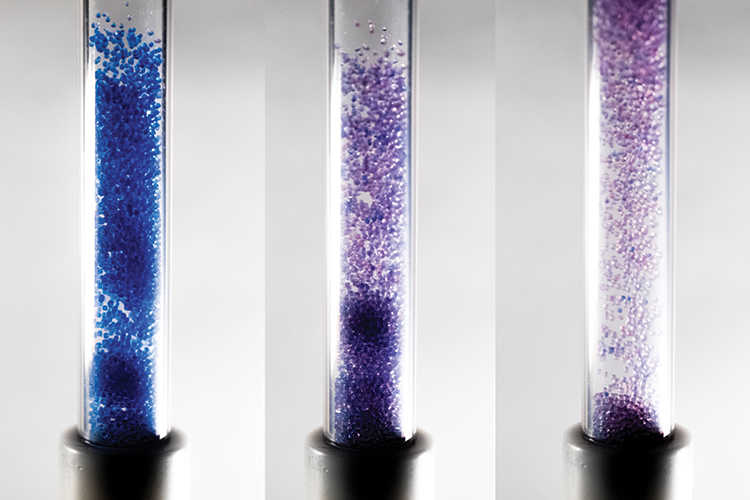
SwRI researchers are using these silica gel beads as part of a low-cost, large-scale method to harvest water molecules from the air. As they expel moisture, the beads turn from blue to pink.
"The water vapor will attach to the adsorbent material through hydrogen bonding. When we introduce heat, the water is exuded in gaseous form, but at much higher humidity," Supak said. "This high-humidity air can be more easily condensed, and the result is potable water."
SwRI is using a fluidized bed process to increase the water production by flowing air through the pellets of material to enhance adsorption and desorption rates. Other researchers use a simpler fixed bed of adsorbent material and rely on day/night cycles to produce water. The SwRI system is designed to yield about 5 liters of water a day, about 10 times more water than techniques demonstrated by other researchers.
The team plans to test the system for up to 1,000 cycles — 10 times more than any previous demonstration — to understand if material performance degrades over time.
High Noon on Jupiter Moon
Using spectral images from the Hubble Space Telescope (HST), a team of scientists led by Dr. Lorenz Roth of the KTH Royal Institute of Technology in Stockholm, Sweden, has determined that water vapor forms a large fraction of the atmosphere of Jupiter's icy moon Ganymede. SwRI scientists played a crucial role in this discovery, looking at the HST datasets and comparing them to the expected values of atmospheric emissions.

Courtesy of NASA/ESA/K. Retherford/SwRI
This artist's depiction of Ganymede's atmosphere shows molecular-oxygen-produced ultraviolet emissions in green and water-vapor-produced UV emissions in red. SwRI scientists helped determine that Ganymede's water atmosphere is concentrated at the equator near noon when the Sun is directly overhead.
Ganymede's atmosphere is produced by charged particle erosion and sublimation of its icy surface. Sublimation occurs when an ice changes directly into a gas without first turning into a liquid. The new observations find that H2O is more abundant than oxygen when the Sun is directly overhead where its rays strike the surface most intensely.
"Sublimated water vapor at high noon on Ganymede, where the surface is relatively warm, is likely a key feature of the tenuous atmospheres of Jupiter's icy moons," said SwRI's Dr. Kurt Retherford, a co-author of the Nature Astronomy paper describing this research. "As we prepare to launch NASA's Ultraviolet Spectrograph (UVS) instrument, built and led by SwRI, aboard the European Space Agency's (ESA's) Jupiter Icy Moons Explorer (JUICE) mission next year, this new understanding of Ganymede's atmosphere will let us better plan our observations and enhance our the quality of the scientific data we gather."
Scientists expect that molecular oxygen is globally the most abundant constituent in Ganymede's atmosphere, as it is gravitationally bound, stable and less likely to react with surface materials.
"It's interesting to think of an atmosphere that has a very different composition on its dayside relative to its nightside, with completely different processes driving the production of gases at different locations," said Dr. Philippa Molyneux, an SwRI co-author. "Imagine if Earth's atmosphere worked that way, and how life might have evolved to adapt to that changing environment."
Landing on the Far Side of the Moon
To advance understanding of Earth's nearest neighbor, NASA has selected three new lunar investigations, including a payload suite led by SwRI. The Lunar Interior Temperature and Materials Suite (LITMS) is one of two packages that will land on the far side of the Moon, a first for the agency, as part of NASA's Commercial Lunar Payload Services, or CLPS, initiative.
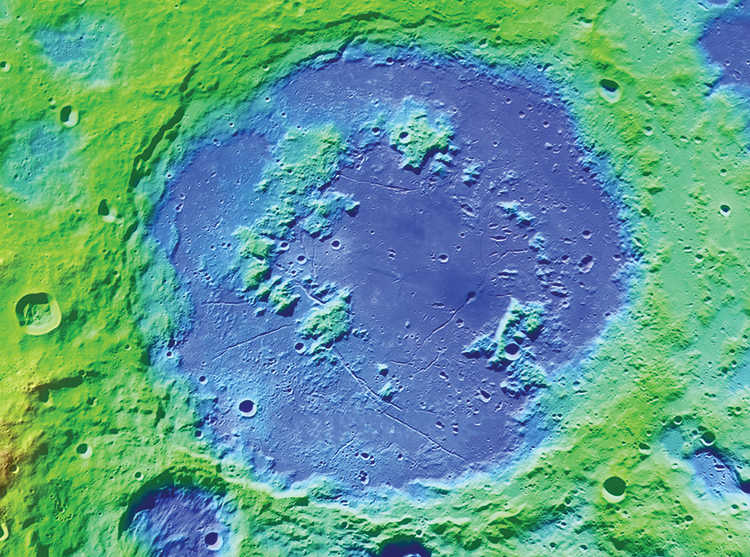
Courtesy of LPI/USRA/NASA
SwRI's Lunar Interior Temperature and Materials Suite will be one of two investigations to land on the far side of the Moon — a NASA first — here in Schrodinger's basin, to study the thermal evolution, differentiation and asymmetry of Earth's closest neighbor.
"With LITMS, we hope to get a better understanding of the thermal evolution, differentiation and asymmetry of the Moon," said SwRI's Dr. Robert Grimm, LITMS principal investigator. "This will help us interpret how the lunar crust, mantle and core formed. And we can contrast these far-side measurements with those done by the near-side Apollo missions to unravel the origin of the 'Man in the Moon.'"
The moon is "tidally locked," meaning that one side is always facing Earth. The far and near sides of the Moon are remarkably different in crustal thickness, composition and cratering. The near side — the side we see — contains an area of high volcanic activity where lava has frozen into dark "seas" called maria. Nearly two-thirds of the maria are on the western near side of the Moon. Throughout history, people have linked the dark maria with fanciful shapes, including a "Man in the Moon" visage.
LITMS is headed to a far-side location chosen by NASA; specifically, the 200-mile diameter Schrödinger basin located in the ancient South Pole-Aitken basin. The suite includes two instruments: The Lunar Instrumentation for Thermal Exploration with Rapidity (LISTER), led by Texas Tech University, and the Lunar Magnetotelluric Sounder (LMS). LISTER measures heat flow using a pneumatic drill to probe up to 10 feet into the subsurface. LMS will determine the electrical conductivity of the Moon's interior by measuring natural electric and magnetic fields.
"Joint measurements of heat flow and electrical conductivity allow us to separate the temperature and material dependence of each," Grimm said. LITMS is scheduled to launch in 2024.
LAD Flies Again
Blue Origin's New Shepard suborbital rocket launched from Van Horn, Texas, August 26 carrying five variations of the SwRI-developed tapered liquid acquisition device (LAD) for testing. Designed to safely deliver liquid propellant to a rocket engine from fuel tanks, the devices must be evaluated in microgravity.
SwRI collaborated with NASA to develop the tapered LAD in the late 1990s and early 2000s as part of cryogenic fluid management capabilities for long spaceflights. Most rocket engines use cryogenic liquid propellants as fuel. A long spaceflight would require large amounts of fuel to be stored at low temperatures and then transferred to the rocket engine, but the straight channels in current LADs are vulnerable to internal vapor bubbles.
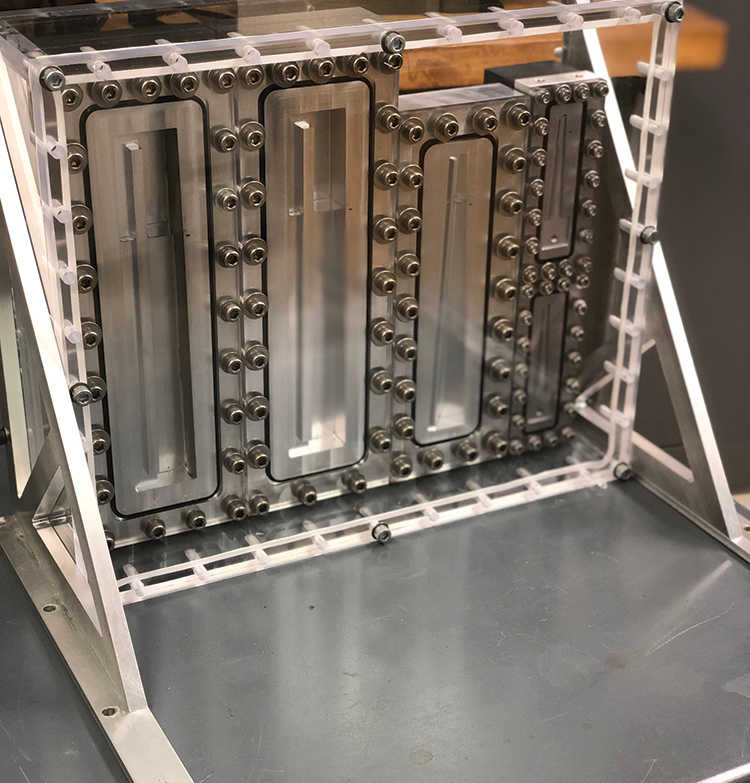
SwRI tested these five different versions of LAD to see if angle or surface properties affect the device's performance.
"LADs have historically been used in spacecraft, but low-gravity cryogenic applications require a more robust design for managing internal vapor bubbles," said Kevin Supak, the project's principal investigator. "The tapered LAD is being developed to offer a simple, low-cost solution to delivering vapor-free liquid to a fuel tank or an engine."
Supak, along with SwRI engineers Dr. Amy McCleney and Steve Green, designed the LAD's tapered channel, which passively removes the bubbles through surface tension. This is the third time SwRI has tested the LAD aboard Blue Origin's New Shepard rocket. The 10-minute flight was ideal for the experiment, providing roughly three minutes of high-quality microgravity, significantly more than the 25 seconds of microgravity achieved in parabolic flights.
The team tested five different versions of LAD to see if the angle or surface properties affect the device's ability to passively remove gas bubbles in microgravity. A camera recorded the behavior of vapor bubbles inside the five LADs.
"Every test moves us closer toward what we believe a tapered LAD inside an actual rocket would look like," McCleney said.
Automating Army Vehicles
SwRI has received an indefinite delivery, indefinite quantity (IDIQ) contract worth up to $34 million over five years to support the U.S. Army Ground Vehicle Systems Center through research and development of autonomous and robotic vehicles.
"SwRI is proud to continue developing the latest autonomous and robotic systems for the U.S. military," said Joseph Hernandez, a principal engineer overseeing the program. "This IDIQ contract offers a more direct link to our end customers and allows us to provide innovative solutions to support our warfighters."
Through the Defense Technical Information Center Information Analysis Center Multiple Award Contract, SwRI will support project management, research and development, modeling and simulation, software development, systems integration, testing and data analysis services, focusing on robotics and autonomous systems.
SwRI's work focuses on developing autonomous capabilities on mobile platforms ranging from compact, purpose-built autonomous vehicles to automated high-mobility, multipurpose wheeled vehicles (HMMWV) and larger tactical vehicles. The Institute also has developed aerial drones integrated with military ground vehicles.
SwRI began developing automated vehicle technology in 2006 through a multidisciplinary internal research program, the Mobile Autonomous Robotics Technology Initiative, or MARTI. The project has evolved to serve military and commercial clients with development of automated systems using sensors, machine learning and connected and automated vehicle technologies.
For more than a decade, SwRI has supported the Army with development of autonomous vehicle systems. These robotic systems have been integrated onto more than 15 unique military ground vehicle platforms, some of which were deployed overseas as part of the Dismounted Soldier Autonomy Tools program. SwRI also played a key role in developing the Robotic Technology Kernel, an autonomy software library that provides a set of common robotic capabilities across a variety of vehicle platforms.

Searchable Additive Manufacturing Database
SwRI is creating a searchable database of additive manufacturing (AM) projects and components. Funded with $50,000 from America Makes, the project will use data management tools that were created through SwRI's internal research program.
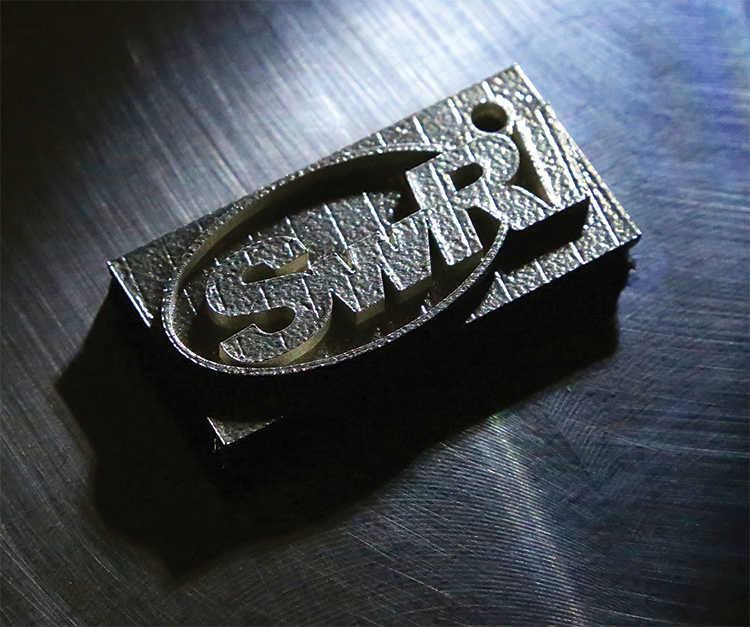
SwRI used additive manufacturing to create this build of its logo. With funding from America Makes, SwRI will create a searchable database of additive manufacturing projects and components, using internally funded data management tools.
Additive manufacturing is a novel process that uses 3D printing, or rapid prototyping, to build an item by layering plastic, metal and other materials using a computer-generated design. The additive manufacturing industry is expected to grow to $51 billion by 2030, according to an April 2021 report by Lux Research. Because it creates sturdy components with intricate design qualities, additive manufacturing appeals to a wide range of users, including the aerospace, medical and manufacturing industries.
"Additive manufacturing is a complex process," said SwRI Research Engineer Shengyen Li. "There are hundreds of variables involved, so a searchable database would be an exceptional tool."
AM projects begin as computer-aided design models, which can be uploaded into 3D printers to produce metal and plastic components. Using an existing database of more than 200 AM projects, Li will use an SwRI-developed tool to add metadata and keywords from the files into the database to make them searchable.
"It's a potential gold mine," said Li, a member of SwRI's Materials Engineering Department, which is leading several additive manufacturing research projects. "With a searchable database, if you're creating an engine blade using additive manufacturing, you could search the database for similar designs instead of starting from scratch."
The searchable database will be available to members of America Makes, the nation's leading public-private partnership for AM technology and education. More than 200 members from industry, academia, government, workforce and economic development organizations work together to accelerate the adoption of AM and the nation's global manufacturing competitiveness.

